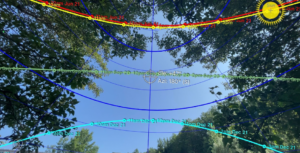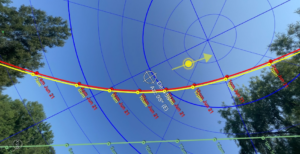Measuring Shade on Those Thin Spots on Your Lawn
About Measuring Shade on Those Thin Spots on Your Lawn
As we get into the dog days of summer, we expect the lawn to face a lot of stress before we come out the other side into the cooler, more hospitable autumn weather. Heat and drought are the 2 biggest stressors through July and August, but shade can play an insidious role too. Often, lawns thin out due to lack of photosynthesis, which requires an average of 4-6 hours of direct sunlight per day. Many lawns thin out during the summer as the trees are full of leaves and the grass just doesn’t get what it needs.
In addition to lack of sunlight, excessive temperatures actually shut down photosynthesis in cool season plants, which includes lawns in the northeastern USA. So if the direct sunlight is hitting the grass in the middle of the afternoon on hot days, the sunlight is largely worthless as the plant is too hot to use it.
So how can you determine whether or not an area of your lawn is thinning out due to lack of sunlight? Simple, there’s an app for that.
We like to use an app called “Sun Seeker.”

If you download it to your smartphone and open up the 3-D feature, you can see an image through the camera feature with lines delineating the path of the sun through the day at a few different times of year. See the image below. At the top is today’s path shown in yellow, very close to the June path in red. The olive green path in the middle represents September 23 (the first day of Autumn) and the light blue line at the bottom is Dec 21.
Following the yellow path of today’s sun. We can see that the patch of grass I’m standing on will be getting only a few hours of direct sunlight, from about 12 PM until 2 PM as it passes between the trees. In September, it’ll be getting more like 4.5 hours of direct sunlight between 10:30 AM and 3:00 PM. So we know that this patch of grass is getting minimal direct sunlight and we can expect it to thin out as the season progresses.

Let’s contrast that with the image below, which shows another patch of grass getting direct sunlight from 7:00 AM until about 2:00 PM, or about 7 hours. We would expect that this area will do much better through the summer, provided it is getting sufficient water and proper mowing.

In many cases where the direct sunlight is not quite enough, the trees actually allow just enough filtered sunlight through the trees so that the lawn area is able to survive, and sometimes even thrive during the summer months. But some tree cover is just too dense.
If you have areas of the lawn that are suffering, or suffer every year as we approach the end of the summer, it’s possible that those areas just aren’t getting enough sunlight. Download the Sun Seeker app and go take a look. If there’s too much shade, you can choose to either live with a thinning lawn each season, or perhaps you can do some selective tree limb pruning to open up the sky a bit more and allow the grass to get the sunlight it needs.
